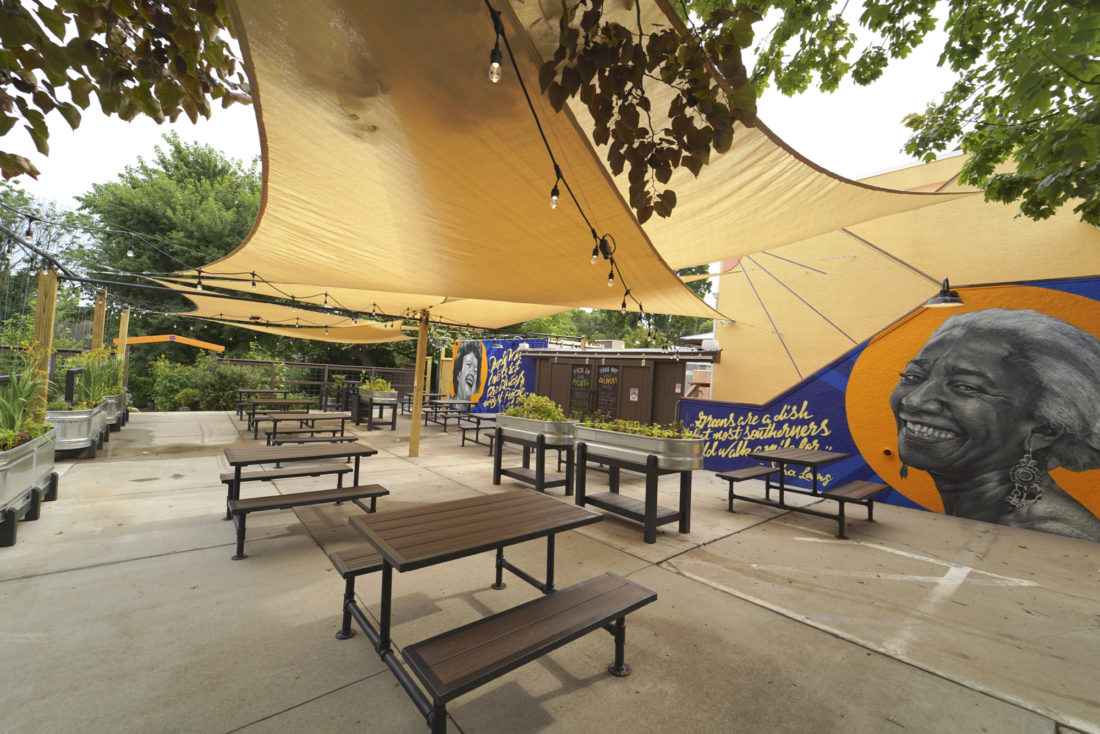“I joke that we have opened three different restaurants in the past four months,” says April Moon Harper of Sunny Point Café, the West Asheville restaurant she opened 18 years ago with her mother, Belinda Raab. After the state shut down dining rooms in March due to COVID-19, the restaurant switched to takeout, then closed and later reopened to do family-style takeout.
“The end of May, we were allowed to reopen at half-capacity, but our dining room is too small for that,” says Harper. “We had to think how we could move forward and keep our DNA intact. And then the city presented this plan.”
The plan, explains Dana Frankel, downtown specialist for the city of Asheville, is one that allows businesses — particularly restaurants — to use private parking lots, public sidewalks and designated on-street parking spaces in front of their businesses as additional space to set up retail and safely distanced dining. “There was a lot of encouragement from the community to create opportunities to continue doing business, and we were seeing things other cities were doing to allow restaurants to create expanded dining,” she explains.
The trick was figuring out how to create distanced outdoor spaces downtown and in other densely populated commercial corridors. “We had to think outside the box on what resources the city could offer to support economic recovery, and we realized we do manage streets and sidewalks,” says Frankel.
With permission from the city, businesses with private parking lots, such as Sunny Point and Zia Taqueria (also in West Asheville), can now convert 50% of their parking area to dining. To expand onto public sidewalks, says Frankel, businesses must be able to maintain 6 feet of clear space for diners and pedestrians.
On the city of Asheville’s development portal, there are links to applications for both options and a third to apply to turn public parking spaces into “parklets.” “The turnaround for private property and public sidewalks [applications] is about one day,” says Frankel. “It’s trickier on public streets and parklets because you’re trading out one public use for another use. That turnaround has been about a week. We’re doing our best to balance the needs of everyone and respond to this crisis.”
Parklets are already popping up on several downtown streets designated as pedestrian priority areas or shared streets, including Wall Street, where Early Girl Eatery’s five tables with bright red umbrellas resemble a European sidewalk café. “I didn’t know what a parklet was until Dana showed me the concept, and I said, ‘Oh, my gosh, this is amazing!’” says Jesson Gill, who owns the restaurant’s three locations with his wife, Cristina. “Even before COVID, people would walk by and think we didn’t have a dining room. Now people walk up, they want to sit outside, there’s tables and chairs, and they love it. It’s like a beacon calling people to stop and eat. It’s awesome of the city to figure this out.”
Robert Tipsword, operating partner of Zia, agrees that Asheville planners deserve an A-plus. “The city created this great one-stop, online shop with all the information you need without having to apply for new permits or pay for anything. They really hit a home run.”
Tipsword created his 14-table al fresco dining room by thinking inside the box. “When we determined the open-air concept was the way to go, I went out to the parking lot with a stick of chalk and started drawing,” he recalls. He drew numbered blue, red and yellow squares with spacing more generous than that called for by Centers for Disease Control and Prevention guidelines.
“We are running a fast-casual, no-reservation restaurant now, so the trick is that the line to the order counter be visible to the people sitting so they don’t camp out for an hour and a half,” he explains. “We also offer drinks to people in line to make that wait easier.”
The project was the ultimate in DIY for Tipsword and his staff. With orders for preassembled picnic tables backed up, they bought lumber and built them themselves. Likewise, they bought 150 feet of plastic chain and strung it on stanchions they made of PVC pipe. Hand-painted signs are in primary colors and simple. “Don’t get too wordy,” he advises. “Entrance, exit and wrong way.”
Before posting her signage, Harper’s priority was resurfacing Sunny Point’s parking lot so the picnic-style tables — built by a local craftsperson Susan Link — could be placed there and posts could be installed for anchoring shade sails. More tables and Adirondack chairs with attached tabletops are set around the meandering, lush garden, tended by the restaurant’s marketing person, Alice Oglesby. Reflective of the restaurant’s DNA are two large, striking murals by artist Gus Cutty of Harper’s personal culinary heroines, iconic chefs Julia Child and Edna Lewis.
“We used our grant from the Tourism Jobs Recovery Fund for this, so it was important we put that money back into the community by contracting with locals,” says Harper. “The murals are so joyful, and we need more of that these days.”




The better next step would be to entirely abolish minimum parking requirements for new and existing development, so we can add local business to downtown without adding useless sprawl. You want to funnel more money into public transit downtown? Stop forcing people to add parking and it will become very easy to get more money for public transit. People will even begin to use our heretofore useless bus lines.
Buses aren’t useless for the people who rely on them, but they could be a lot better.
But I agree: minimum parking requirements are dumb. It’s also a good time to consider permanently reducing on-street parking other than handicapped provision and pedestrianizing some downtown streets (esp. Wall Street) during normal business hours.